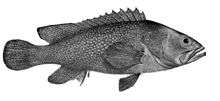Epinephelus summana
Epinephelus summana, the summan grouper, is a species of marine ray-finned fish, a grouper from the subfamily Epinephelinae which is part of the family Serranidae, which also includes the anthias and sea basses. It comes from the Eastern Indian Ocean that occasionally makes its way into the aquarium trade.
| Epinephelus summana | |
|---|---|
 | |
| Scientific classification | |
| Kingdom: | Animalia |
| Phylum: | Chordata |
| Class: | Actinopterygii |
| Order: | Perciformes |
| Family: | Serranidae |
| Genus: | Epinephelus |
| Species: | E. summana |
| Binomial name | |
| Epinephelus summana (Forsskål, 1775) | |
| Synonyms[2] | |
| |
Description
Epinephelus summana has a standard length which is 2.7 to 3.1 times its depth. It has a flat or slightly concave region between the eyes. The preopecle is has slightly enlarged serrations at its corner and the gill cover has a highly convex upper margin.[3] There are 11 spines and 14-16 soft rays in the dorsal fin and 3 spines and 8-9 rays in the anal fin.[2] The membranes between the dorsal fin spines are notched. The caudal fin is rounded.[3] The overall colour is dark olive-brown to dark brownish grey with large pale blotches, the majority being greater in size than the eyes, and abundant small white spots which lie over this pattern. The fins are covered with small white spots, apart for the pectoral fins where they are restricted to its base. This faihs attains a maximum standard length of 52 centimetres (20 in)[2]
Distribution
Epinephelus summana is found in the western part of the Indian Ocean. It is found in the Red Sea, the Gulf of Aden and off Socotra.[1]
Habitat and ecology
Epinephelus summana is a reef-associated species that occurs in shallow protected coral reefs and in shallow lagoons and seaward reef slopes (1 to 30 m) or brackish-water environments. No published information on the biology of this species has been found.[2]
Taxonomy
Epinephelus summanawas first formally described as Perca summana in 1775 by the Sedish explorer Peter Forsskål (1732-1763) with the type locality given as the Red Sea.[4]
Utilisation
Epinephelus summana is caught by small, local fisheries and has been recorded in fish markets in Egypt and Sudan.[1] It also sometimes appears in the aquarium trade.[5]
References
- Samoilys, M. (2018). "Epinephelus summana". IUCN Red List of Threatened Species. 2018: e.T132728A100559239. doi:10.2305/IUCN.UK.2018-2.RLTS.T132728A100559239.en. Retrieved 26 December 2018.
- Froese, Rainer and Pauly, Daniel, eds. (2019). "Epinephelus summana" in FishBase. December 2019 version.
- Heemstra, P.C. & J.E. Randall (1993). FAO Species Catalogue. Vol. 16. Groupers of the world (family Serranidae, subfamily Epinephelinae). An annotated and illustrated catalogue of the grouper, rockcod, hind, coral grouper and lyretail species known to date (PDF). FAO Fish. Synopsis. 125 (16). FAO, Rome. pp. 232–233. ISBN 92-5-103125-8.
- Eschmeyer, W. N.; R. Fricke & R. van der Laan (eds.). "Perca summana". Catalog of Fishes. California Academy of Sciences. Retrieved 17 July 2020.
- "Epinephelus summana (Forsskal, 1775) Summan Grouper". Saltcorner. Retrieved 17 July 2020.
- Froese, Rainer and Pauly, Daniel, eds. (2008). "Epinephelus summana" in FishBase. December 2008 version.
